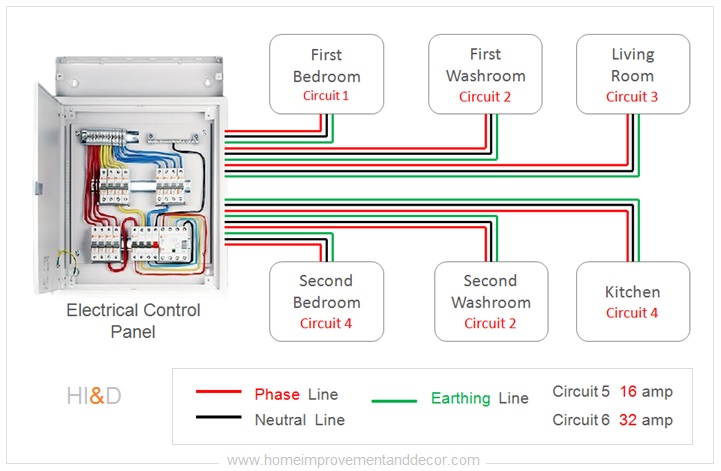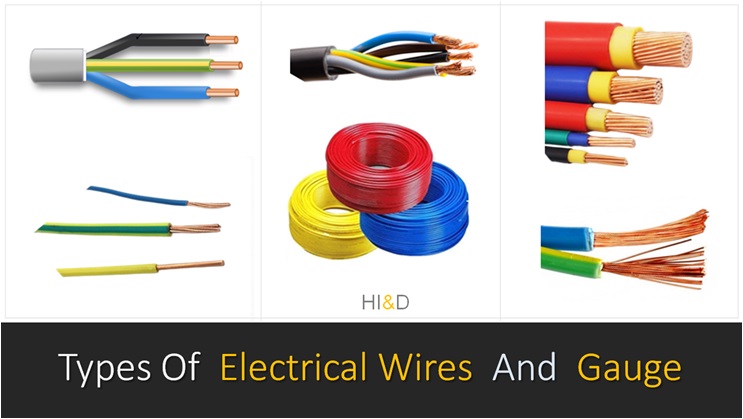
Types Of Electrical Wires And Cables
Complete DIY House Electrical Work
How To Select Electrical Wires ?
Learn about different types of electrical wires and cables used for the electrical wiring of the house. The selection of the wire is an important decision, and it depends upon a number of factors.
If you are planning to remodel your house interior or change the existing wiring system, then selecting the right wire and other components is a crucial decision.
The selection of the electrical wires depends upon the purpose and the electrical load that the electrical wire needs to safely handle.
The main electrical wire and cable types include single conductor wire ( single strand wire), multi-conductor wire ( stranded wire ) , single , two and three-core cables, and armored wire ( armored cable ).
The house wiring system also needs other types of non-electrical wires such as earthing wire, speaker wire, CCTV wires, HDMI cable , telephone wire, and earthing wire.

The capacity of the electrical wire to support the specified electrical load depends upon its size ( area or diameter ) and other technical specifications.
In this article, you will learn about different types of electrical wire and cables used for residential electric wiring projects , how to select wires, wire sizes, gauges, rated ampere capacity, and other important related topics.
The information in this article will help you understand some fundamental knowledge about the basics of house electrical wiring and how to select electrical wires for your DIY project.
Types Of Electrical Wires And Cables
Types Of Electrical Wires And Cables
Complete Guide To Home Electrical Wiring
Table Of Contents
The electrical wires carry the electrical current from the main control panel to the various electrical points placed on the switch boards.
The term “wire” is often used to refer to an electrical cable. In electrical jargon, the term “wire” is used to indicate the conductor.
Whereas, in electrical jargon, the term “cable” simply means a wire with an insulation cover. However, it is a common practice to refer to a cable as a wire that is mostly used for home electrical wiring.
The electrical wires consist of a metallic conductor that actually carries the electric current. Different types of metallic conductors are used to manufacture the electrical wires.

An electrical wire consists of either a single conductor or multiple conductors stranded together as one conductor.
All electrical wires carry a cover of insulation material such as PVC or rubber to prevent contact between the two wires.
The protective insulation cover on the wire also protects the user. The wires carry a live electrical current, and any accidental touch can cause fetal electric shock.
The quality of the electrical wire is judged by the purity of its conductor material, the quality of its insulation, and the thickness of the insulation material used in the wire.
Types Of Electrical Wires And Cables
Solid wire and stranded wire are two basic types of wires based on the number of electrical conductors present in the wire.
A single-conductor wire is called a solid wire or a single-strand wire. A stranded wire is a wire that has multiple conductors bound together.
In solid wire, a single conductor is used for the flow of electricity. A solid wire is more durable but lacks the flexibility . A strand wire is relatively more flexible as compared to a solid wire, and it can easily bend as per the shape of the conduit.
The wires are mainly used in the electrical wiring of a house and are placed inside the conduit. The electrical wires are used for connecting the electrical circuits with the main control panel
Depending upon the type of the wiring system , the electrical wires can be placed inside the casing and capping type conduit. In the case of a concealed wiring system, the wires are placed inside the PVC pipe concealed inside the wall.
The electrician uses both solid wires and stranded wires depending upon the application and the wire flexibility requirements.
The selection of the type of wire, rated capacity, and other technical specifications depends upon the electrical layout plan for a house.

Types Of Electrical Wires And Cables
A single metallic conductor is referred to as a “wire” in the electrical jargon. whereas the wire ( conductor ) with an insulation cover is referred to as a cable.
In simple words, any conductor with an insulation layer is called a cable. Depending upon the number of conductors , a cable can be a single core , two-core, or multiple-core cable.
Electrical cables are generally sold on the market by various brands. Most countries have a uniform standard ( AWG and SWG ) in place for electrical cables that defines the rated capacity and other technical specifications.

The electrical cables consist of three important parts. The innermost component of the cable is the metallic conductor. The middle layer is called dielectric (insulation material), and the outermost layer is called a sheath.
Different types of cables are used for the electrical wiring of a house. The technical features of the cables include armored cables and submersible cables.
The armored cable comes with an additional layer of armor that protects the wire from physical damage. These cables are used for underground electric connections.
Types Of Electrical Wires And Cables
Different types of electrical cables are used in the house’s electrical wiring work . The type of cable used depends upon the nature of its application and the rated capacity.
On the basis of the conductor material, the cable types include copper cables and aluminum cables. Similarly, on the basis of usage, the cable types include over-general purpose cables and underground armored cables.

The cable types are also specified on the basis of the cross-section area of the conductor . In the cable rating table, the cross section area of the conductor is specified in square millimeters with the corresponding current carrying capacity in amperes.
Some reputed electric brands offer cables with additional features such as double PVC and cables with fire retardant properties.
The house wiring work also needs other types of wires and cables that do not carry the electrical current. These cables are an essential part of the house wiring system.
Telephone cables, CCTV cables, speaker wires, HDMI cables, coaxial cables, and earthing wire are examples of non-electrical cables. The earthing wire is a special wire without any insulation cover.
Types Of Electrical Wires And Cables
The house’s electrical wiring typically needs different types of wires (technically, cables ) for the electrical wiring project.
For example, you might need an armored cable that connects an outside electric service pole to the main control panel of your house.
Similarly, for the internal house electrical wiring , we also need different types of electric cables ( you can call them wires) with different rated capacities ( specified as amperage ).

The selection of the cables depends upon the electrical layout plan of the house. The electrical layout plan indicates how the electrical load for various rooms is distributed into a number of circuits.
The layout plan also defines the layout of the cables from the main control panel to the destination electric switch boards. Depending upon the electric load on the circuit, the electrical wires with a specified amperage are selected.

For example, the electrical circuits that are used for the highest electrical load, such as room heaters, hot water geysers, and air conditioners ( AC), typically need 4 mm to 6 mm cable or even higher size cable that supports 50 ampere current.
Similarly, the cables used for the lowest electrical load circuits (such as led bulbs and ceiling fans ) typically need 0.75 sq mm to 1.5 sq mm cable size cable that supports up to 7 amps of current capacity.
The exact size of the cables required is worked out as per the detailed electrical load calculation. You can refer to the cable size rating table (also called the wire table) to find the wire rated capacity.
Cable Cross Section Area | Cable Current Rating | Circuit Braker MCB |
1.5 Sq.mm | 7.9 - 15.9 Ampere | 8 Ampere |
2.5 Sq.mm | 15.9 - 22 Ampere | 15 Ampere |
4 Sq.mm | 22 - 30 Ampere | 20 Ampere |
6 Sq.mm | 30 - 39 Ampere | 30 Ampere |
10 Sq.mm | 39 - 54 Ampere | 40 Ampere |
16 Sq.mm | 39 - 54 Ampere | 60 Ampere |
25 Sq.mm | 39 - 54 Ampere | 80 Ampere |
50 Sq.mm | 54 - 72 Ampere | 125 Ampere |
70 Sq.mm | 72 - 93 Ampere | 150 Ampere |
95 Sq.mm | 117 - 141 Ampere | 200 Ampere |
Types Of Electrical Wires And Cables
The AWG stands for American Wire Gauge used in the US for measuring the size of the electrical wire and the current it can safely handle.
In the AWG system, the higher gauge number corresponds to the smaller size of the wire. The smaller size wire has a higher gauge and carries less current.
For example, the wire with an AWG of 10 has a diameter of 2.588 mm and can safely carry 30 amperes of current. Similarly, the wire with an AWG of 20 has a diameter of 0.812 mm and can safely carry 5 amps of current.

The resistance per unit of wire length is another important factor that needs to be taken into account. In the AWG system , the wire with AWG 10 has a resistance of 1 miliohm and the wire with AWG 20 has a resistance of 10 milliohms.
The SWG stands for Standard Wire Gauge, and is a British rating standard used in the UK for measuring the size of the electricity wire and the current it can safely handle.
The SWG system is quite similar and comparable to the AWG system. In the SWG system , the higher gauge number corresponds to the smaller size of the wire. The smaller size wire has a higher gauge and carries less current.
Types Of Electrical Wires And Cables
In simple words , the electrical voltage is the measure of pressure for the flow of electricity. For the sake of simplicity, we can compare the voltage to the water pressure in a pipe.
The two main types of voltage are AC voltage and DC voltage. The term AC stands for alternate current, and the term DC stands for direct current.
The electricity supply for residential units is of the alternate current ( AC ) type. For example, the In the United States, the voltage for residential use is 120 Volts at 6 oHertz. In the United Kingdom and India, the voltage standard is 230 volts at 50 hertz.
Electrical Measure | Used For Measuring | Depends On |
Voltage | Pressure | Electric Supply |
Ampere | Current | Wire Size & Rating |
Ohms | Resistance | Conductor Type |
Wattage | Power Requirment | Wattage Of Gadget |
whereas the ampere is the unit used for the measurement of electric current. In short, an ampere is abbreviated as an amp. The term “amperage” is used to indicate the strength of electric current in an ampere.
Wattage is a unit of measurement of electrical power requirements. The term “wattage” is associated with the electrical power requirement of the gadget.
For example, heavy consumption gadgets such as room heaters, water geysers, and air conditioning units ( AC ) usually require high electrical power to function.




